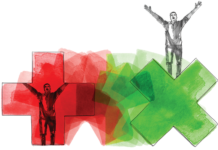“Immense blocks of ice, harvested as free-floating icebergs from a fjord outside Nuuk, Greenland, stood from 11 December 2018 in a grove of 24 blocks on Bankside, outside Tate Modern, and in a ring of 6 blocks in the City of London, outside Bloomberg’s European headquarters, until they melted away.
“Each block of ice weighed between 1.5 and 6 tonnes. Fished out of the Nuup Kangerlua fjord, they had already been lost from the ice sheet and were melting into the ocean. The Greenland ice sheet loses 10,000 such blocks of ice per second throughout the year; fishing these blocks of ice from the sea did not affect the quantity of ice in Greenland,” (Ice Watch, 2018).
“WPJ: What impact do you hope Ice Watch will have on the climate conference?
“MTR: I hope several things. Mostly, I hope that it makes people ponder. Makes it clear that there is a physical reality that one cannot argue away, and that we have to observe and act upon. I also hope it makes people engaged in nature in a positive way. People are touched—often happy—when they touch, listen to, smell, taste, and feel the icebergs. I think it is important that our actions regarding climate change are driven by things we wish to obtain rather than things we deprive ourselves of. Icebergs are beautiful and we cannot afford to lose them from our world. And people who wish to counter climate change are not necessarily driven by fear, parsimony, and dread, but by beauty, fun, and splendor.
“As Rosing emphasizes, the tactile element of Ice Watch is crucial to the way the public interacts with the piece. Global warming is often thought of as an imperceptible phenomenon, particularly for people who do not live in environments where rising seas or melting ice directly affect their daily lives. Putting glacial ice in the center of Paris allows passersby to touch the ice and to watch the size of the chunks slowly diminish each day. As Maria Thomas, a student who lives near Place du Panthéon, comments, “It’s so stark to see it melting in front of your eyes.”
“A common immediate reaction to Ice Watch is surprise at seeing large pieces of glaciers in the middle of the city, but those who linger in the square to fully take in the experience are often inclined to touch or lean against the ice. As Eliasson and Rosing hoped, people walking by are drawn to the ice and are establishing a physical connection with it—and, with any luck, are contemplating the project’s message about climate change in the process,” (Rosing, 2015).
Eliasson and Rosing’s Ice Watch is inspiring to me in that it tried to counteract the dominant climate change narrative. While the media talked about it as something global and impersonal, Eliasson and Rosing made climate change tangible. While the media described it as dire and violent, Eliasson and Rosing showed how quiet the changes can be. While the media talked about it decisively, Eliasson and Rosing shared the world’s natural beauty and showed that it is worth protecting.
While I can’t know if Ice Watch changed the world, Ice Watch has left a cultural impact. For years, the installation was the topic of climate change discussions and it DID raise awareness about glacial ice melt. Even though I never got to experience the installation for myself, I sometimes think about it and ponder its message. In that sense, the installation was effective, as Rosing has stated that was his goal with the piece.
At this point, “pondering” may not be the action we need, or maybe it is. Maybe we need more personal pro-climate messages that allow people to ponder their place in the world and understand their actions. At the level I am working at with ODNR, that seems the most feasible. Maybe ODNR management needs a nudge to see that sustainability and waste management issues in the parks can be combatted with new systems in place, and maybe I can provide that nudge.
References
Figure 5. Olafur Eliasson and Minik Rosing, Ice Watch [Photograph]. (2015).
ResearchGate. https://www.researchgate.net/publication/
320171495_Visual_art_as_a_way_to_communicate_climate_change_a_psychological_perspective_on_climate_change-related_art
Ice Watch: A public artwork by Olafur Eliasson and Minik Rosing. (n.d.). Ice
Watch. Retrieved September 12, 2024, from https://icewatch.london/
Rosing, M. T. (2015, December 9). Global Warming Becomes Tangible in “Ice Watch”
(Interview by World Policy Journal) [Transcript]. The Henry M. Jackson
School of International Studies, University of Washington. Retrieved
September 12, 2024, from https://jsis.washington.edu/aic/2015/12/09/
global-warming-becomes-tangible-in-ice-watch/




